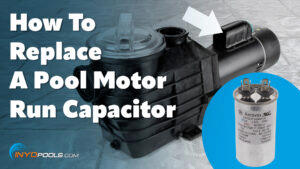Knowing how to test a pool pump capacitor can save you time and money when the pump motor fails. Every day that a pump is down, the likelihood of a lengthy and expensive cleanup increases. Troubleshooting a pump motor should begin with testing the capacitor(s).
What Is a Capacitor?
The basic definition of a capacitor is a device that’s used to store an electric charge. Most pool pump motors utilize a start capacitor and/or a run capacitor. They both look similar to a large battery. Start capacitors are usually located at the back of the motor and the run capacitor is located at the top of the motor.

Symptoms of a Bad Capacitor
Humming. Is your pool pump motor humming, but not turning on? Most pool motors require extra torque to get the motor up to speed. A failed capacitor will prevent the motor from turning over. Another cause of humming could be a seized motor shaft. If you can spin the motor shaft manually, the capacitor is likely the cause of the humming. If the shaft does not spin manually, the bearings or complete motor should be replaced.
Overheating. It is common for pool motors to run on the hot side. However, the motor will shut itself down if it is running too hot. A defective run capacitor can cause the motor to run at a higher amperage. Higher amps mean more wattage and more wattage means more heat. Other symptoms of a pool motor overheating would be an oversized impeller, bad windings or high voltage.
One Speed Working on a Two-speed Motor. There are a couple reasons why a two-speed pool pump motor would only run on high or low speed. As you can probably guess, the run capacitor is a frequent offender. If it’s not the capacitor, it’s likely a bad phase winding and the motor needs to be replaced.
Testing the Capacitor with a Multimeter
- Remove the cover at the back of the motor or on top of the motor to expose the capacitor.

- The capacitor will store an electrical charge. It will need to be shorted out by placing an insulated screwdriver across the leads of the capacitor. CAUTION: Capacitors have been known to explode when shorted out. For this reason, wear eye protection and place a cloth over the capacitor before shorting it out.
- Remove the leads to the pool pump capacitor. Note the placement of the leads so that you can restore them to their correct positions when you reconnect them.
- Set the multimeter on ohms to 1K.
- Slip a heavy piece of paper between the points on the switch.
- Attach one probe to each terminal. On an analog meter the needle should move rapidly to right then slowly drift to the left. If a digital meter is used, readings should start low and rapidly increase to maximum value. If the needle or number starts at zero and doesn’t move, the capacitor is bad and therefore needs to be replaced.
Replacement
Replacement capacitors must have the same MFD or UF rating as the original. If the same voltage rating is not available, it is acceptable to use the next higher voltage. For example, if a 370 volt unit is not available, use the next rating which is a 440 volt.













Leave a Reply